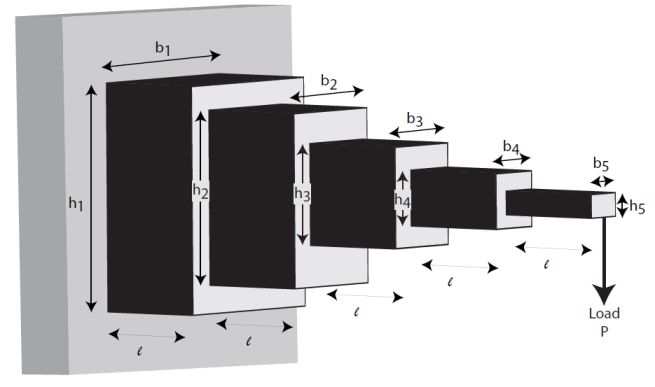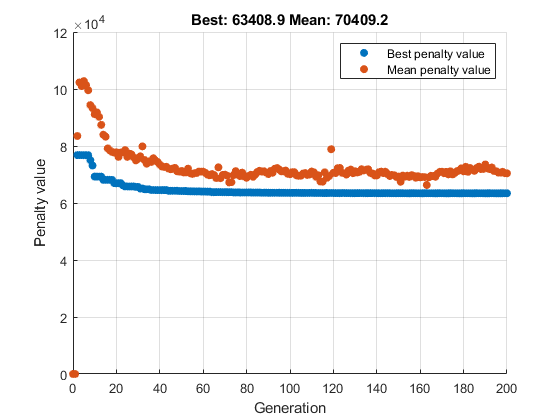使用遗传算法解决混合整数工程设计问题
此示例展示如何使用 Global Optimization Toolbox 中的遗传算法(ga)求解器解决混合整数工程设计问题。
本例所说明的问题涉及阶梯悬臂梁的设计。具体来说,梁必须能够承载规定的端部载荷。我们将解决一个问题,即在各种工程设计约束下最小化梁体积。
在这个例子中,我们将解决 [1] 中发表的两个有界版本的问题。
阶梯式悬臂梁设计问题
阶梯悬臂梁的一端受到支撑,并在自由端施加载荷,如下图所示。梁必须能够支撑距支撑固定距离  的给定负载
的给定负载  。梁的设计者可以改变每个部分的宽度(
。梁的设计者可以改变每个部分的宽度( )和高度(
)和高度( )。我们假设悬臂的每个部分具有相同的长度,
)。我们假设悬臂的每个部分具有相同的长度, 。
。

梁的体积
梁的体积  是个体部分体积的总和
是个体部分体积的总和

设计限制:1 - 弯曲应力
考虑单悬臂梁,其坐标中心位于梁自由端横截面的中心。梁中点  处的弯曲应力由以下公式给出
处的弯曲应力由以下公式给出

其中  是
是  处的弯矩,
处的弯矩, 是距端部载荷的距离,
是距端部载荷的距离, 是梁的面积惯性矩。
是梁的面积惯性矩。
现在,在图中所示的阶梯悬臂梁中,梁的每个截面的最大矩为  ,其中
,其中  是梁的每个截面与端部载荷的最大距离
是梁的每个截面与端部载荷的最大距离  。因此,梁的第
。因此,梁的第  个截面
个截面  的最大应力由下式给出:
的最大应力由下式给出:

最大应力发生在梁的边缘, 。梁的第
。梁的第  个截面的面积惯性矩由下式给出:
个截面的面积惯性矩由下式给出:

将其代入  方程可得出
方程可得出

悬臂各部分的弯曲应力不应超过最大允许应力  。因此,我们最终可以状态五个弯曲应力约束(悬臂的每个台阶一个)
。因此,我们最终可以状态五个弯曲应力约束(悬臂的每个台阶一个)





设计限制:2 - 末端挠度
悬臂的末端挠度可以利用卡斯蒂利亚诺第二定理计算,该定理指出

其中  是梁的挠度,
是梁的挠度, 是由于施加的力而在梁中储存的能量,
是由于施加的力而在梁中储存的能量, 。
。
悬臂梁中存储的能量由下式给出:

其中  是在
是在  处施加力的矩。
处施加力的矩。
鉴于悬臂梁的  ,我们可以将上述方程写成
,我们可以将上述方程写成
![$$U = P^2/2E \int_0^l \! [(x+4l)^2/I_1 \, + (x+3l)^2/I_2 \, + (x+2l)^2/I_3 \, + (x+l)^2/I_4 \, + x^2/I_5 ]\, \mathrm{d} x$$](../examples/globaloptim/win64/steppedCantileverExample_eq17007742970191506642.png)
其中  是悬臂第
是悬臂第  部分的面积惯性矩。计算积分可得出
部分的面积惯性矩。计算积分可得出  的以下表达式。
的以下表达式。

应用卡斯蒂利亚诺定理,梁的端部挠度由下式给出

现在,悬臂的端部挠度  应该小于最大允许挠度
应该小于最大允许挠度  ,这给了我们以下约束。
,这给了我们以下约束。

设计限制:3 - 纵横比
对于悬臂的每一步,纵横比不得超过最大允许纵横比  。即:
。即:
 ,其中
,其中 
陈述优化问题
现在,我们可以状态问题,在给定所述约束下寻找阶梯悬臂梁的最佳参数。
让  、
、 、
、 、
、 、
、 、
、 、
、 、
、 、
、 和
和 
最小化:

取决于:






 、
、 、
、 、
、 和
和 
梁的第一步只能加工到最接近厘米的精度。也就是说, 和
和  必须是整数。其余变量是连续的。变量的边界如下:-
必须是整数。其余变量是连续的。变量的边界如下:-






此问题的设计参数
对于我们将在此示例中解决的问题,梁必须支撑的端部载荷是  。
。
梁长度和最大端部挠度为:
梁总长度,

梁的单个部分,

最大梁端挠度,

梁每一步允许的最大应力,
梁每一步的杨氏模量,
解决混合整数优化问题
我们现在解决陈述优化问题中描述的问题。
定义适应度和约束函数
检查 MATLAB® 文件 cantileverVolume.m 和 cantileverConstraints.m 以了解适应度和约束函数是如何实现的。
关于线性约束的注释:当线性约束指定为 ga 时,通常通过 A、b、Aeq 和 beq 输入指定它们。在这种情况下,我们通过非线性约束函数指定它们。这是因为在这个例子的后面,一些变量将变得离散。当问题中存在离散变量时,在非线性约束函数中指定线性约束要容易得多。另一种方法是修改线性约束矩阵以在转换后的变量空间中工作,但这并不简单,甚至可能不可能。此外,在混合整数 ga 求解器中,无论如何指定,线性约束与非线性约束的处理方式没有任何不同。
设置界限
创建包含下界(lb)和上界(ub)的向量。
lb = [1 30 2.4 45 2.4 45 1 30 1 30]; ub = [5 65 3.1 60 3.1 60 5 65 5 65];
设置选项
为了获得更准确的解,我们增加了 PopulationSize 和 MaxGenerations 选项的默认值,并减少了 EliteCount 和 FunctionTolerance 选项。这些设置导致 ga 使用更大的种群(增加 PopulationSize),增加设计空间的搜索(减少 EliteCount),并一直持续下去,直到其最佳成员变化很小(小 FunctionTolerance)。我们还指定了一个绘图函数来监控 ga 进展过程中的罚函数值。
请注意,在解决混合整数问题时,可用的 ga 选项有限 - 有关更多详细信息,请参阅 Global Optimization Toolbox 用户指南。
opts = optimoptions(@ga, ... 'PopulationSize', 150, ... 'MaxGenerations', 200, ... 'EliteCount', 10, ... 'FunctionTolerance', 1e-8, ... 'PlotFcn', @gaplotbestf);
致电 ga 解决问题
我们现在可以调用 ga 来求解问题。在问题陈述中, 和
和  是整数变量。我们通过在非线性约束输入之后和选项输入之前将索引向量
是整数变量。我们通过在非线性约束输入之后和选项输入之前将索引向量 [1 2] 传递给 ga 来指定这一点。我们还在这里播种并设置随机数生成器以实现可再现性。
rng(0, 'twister'); [xbest, fbest, exitflag] = ga(@cantileverVolume, 10, [], [], [], [], ... lb, ub, @cantileverConstraints, [1 2], opts);
ga stopped because it exceeded options.MaxGenerations.

分析结果
如果问题有整数约束,ga 会在内部对其进行重新表述。具体来说,问题中的适应度函数被处理约束的罚函数所取代。对于可行种群成员,罚函数与适应度函数相同。
从 ga 返回的解显示如下。请注意,最靠近支撑的部分被限制为具有宽度( )和高度(
)和高度( ),这是一个整数值,并且该约束已被 GA 遵守。
),这是一个整数值,并且该约束已被 GA 遵守。
display(xbest);
xbest =
Columns 1 through 7
3.0000 60.0000 2.8504 57.0057 2.6114 50.6243 2.2132
Columns 8 through 10
44.2349 1.7543 35.0595
我们还可以要求 ga 返回光束的最佳体积。
fprintf('\nCost function returned by ga = %g\n', fbest);
Cost function returned by ga = 63408.9
添加离散非整数变量约束
现在工程师们被告知,悬臂的第二步和第三步只能具有从标准集合中选择的宽度和高度。在本节中,我们展示如何将此约束添加到优化问题中。请注意,增加这个约束后,这个问题与[1]中解决的问题相同。
首先,我们状态将添加到上述优化中的额外约束
梁的第二和第三步的宽度必须从以下集合中选择:- [2.4, 2.6, 2.8, 3.1] 厘米
横梁第二和第三台阶的高度必须从以下集合中选择:- [45, 50, 55, 60] 厘米
为了解决这个问题,我们需要能够将变量  、
、 、
、 和
和  指定为离散变量。要指定分量
指定为离散变量。要指定分量  从集合
从集合  中取离散值,请使用
中取离散值,请使用  优化取值范围从 1 到
优化取值范围从 1 到  的整数变量,并使用
的整数变量,并使用  作为离散值。要指定范围(1 到
作为离散值。要指定范围(1 到  ),请将 1 设置为下界,将
),请将 1 设置为下界,将  设置为上界。
设置为上界。
因此,我们首先转换离散变量的边界。每个集合有 4 个成员,我们将离散变量映射到范围 [1, 4] 内的整数。因此,为了将这些变量映射为整数,我们将每个变量的下界设置为 1,上界为 4。
lb = [1 30 1 1 1 1 1 30 1 30]; ub = [5 65 4 4 4 4 5 65 5 65];
当调用 ga 求解器时, 、
、 、
、 和
和  的转换(整数)版本现在将传递给适应度和约束函数。为了正确评估这些函数,需要将
的转换(整数)版本现在将传递给适应度和约束函数。为了正确评估这些函数,需要将  、
、 、
、 和
和  转换为这些函数中给定离散集的成员。要了解如何完成此操作,请检查 MATLAB 文件
转换为这些函数中给定离散集的成员。要了解如何完成此操作,请检查 MATLAB 文件 cantileverVolumeWithDisc.m、cantileverConstraintsWithDisc.m 和 cantileverMapVariables.m。
现在我们可以调用 ga 来解决离散变量的问题。在这种情况下, 是整数。这意味着我们传递索引向量
是整数。这意味着我们传递索引向量 1:6 到 ga 来定义整数变量。
rng(0, 'twister'); [xbestDisc, fbestDisc, exitflagDisc] = ga(@cantileverVolumeWithDisc, ... 10, [], [], [], [], lb, ub, @cantileverConstraintsWithDisc, 1:6, opts);
ga stopped because it exceeded options.MaxGenerations.

分析结果
xbestDisc(3:6) 从 ga 作为整数返回(即处于其转换状态)。我们需要反向转换来检索其工程单位中的值。
xbestDisc = cantileverMapVariables(xbestDisc); display(xbestDisc);
xbestDisc =
Columns 1 through 7
3.0000 60.0000 3.1000 55.0000 2.6000 50.0000 2.2430
Columns 8 through 10
44.8603 1.8279 36.5593
与以前一样,从 ga 返回的解满足  和
和  为整数的约束。我们还可以看到,
为整数的约束。我们还可以看到, 、
、 是从集合 [2.4, 2.6, 2.8, 3.1] cm 中选取的,而
是从集合 [2.4, 2.6, 2.8, 3.1] cm 中选取的,而  、
、 是从集合 [45, 50, 55, 60] cm 中选取的。
是从集合 [45, 50, 55, 60] cm 中选取的。
回想一下,我们已经对变量 x(3)、x(4)、x(5) 和 x(6) 添加了额外的约束。正如预期的那样,当这些变量有额外的离散约束时,最优解具有更高的最小体积。还要注意的是,[1] 中报告的解的最小体积为  ,并且我们发现一个与 [1] 中报告的解大致相同的解。
,并且我们发现一个与 [1] 中报告的解大致相同的解。
fprintf('\nCost function returned by ga = %g\n', fbestDisc);
Cost function returned by ga = 64795
摘要
此示例说明如何使用遗传算法求解器 ga 来解决具有整数约束的约束非线性优化问题。该示例还展示了如何处理问题公式中具有离散变量的问题。
参考资料
[1] Thanedar, P. B., and G. N. Vanderplaats."Survey of Discrete Variable Optimization for Structural Design."Journal of Structural Engineering 121 (3), 1995, pp. 301–306.